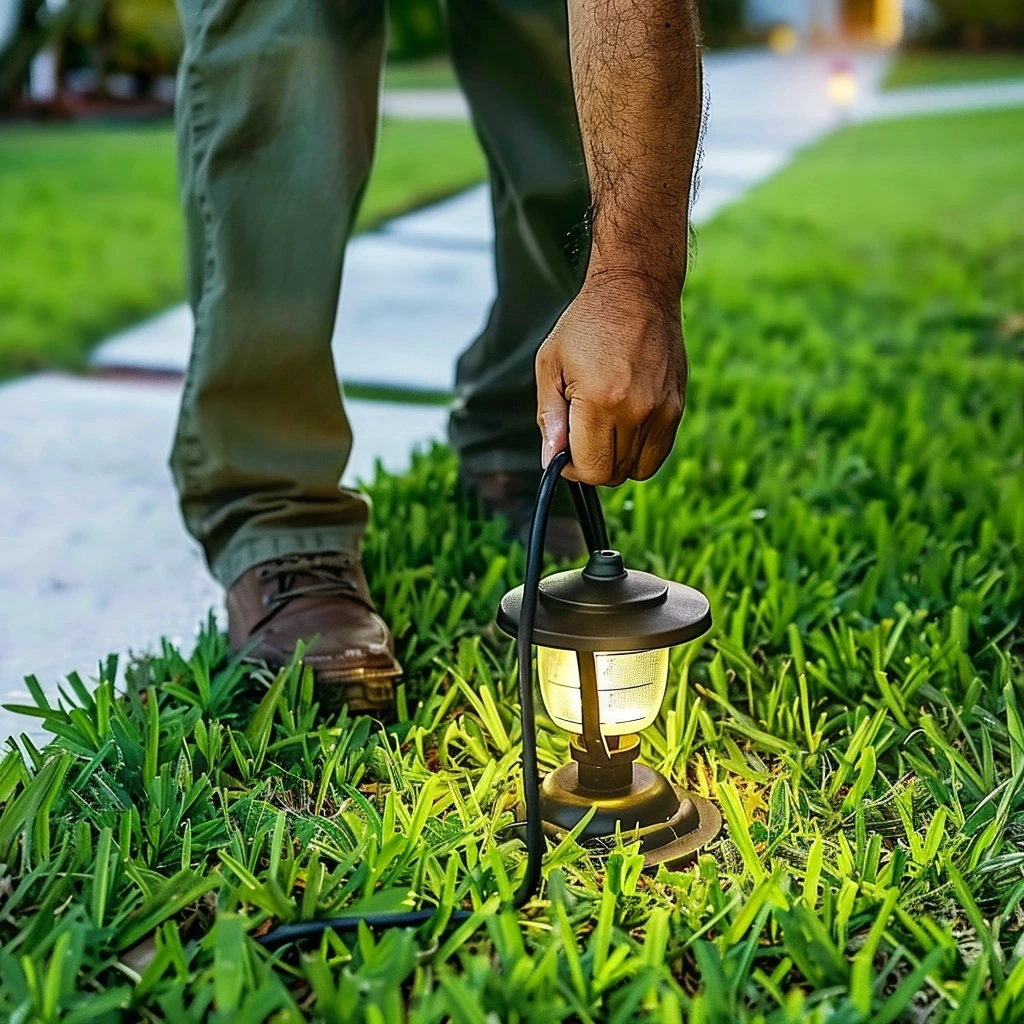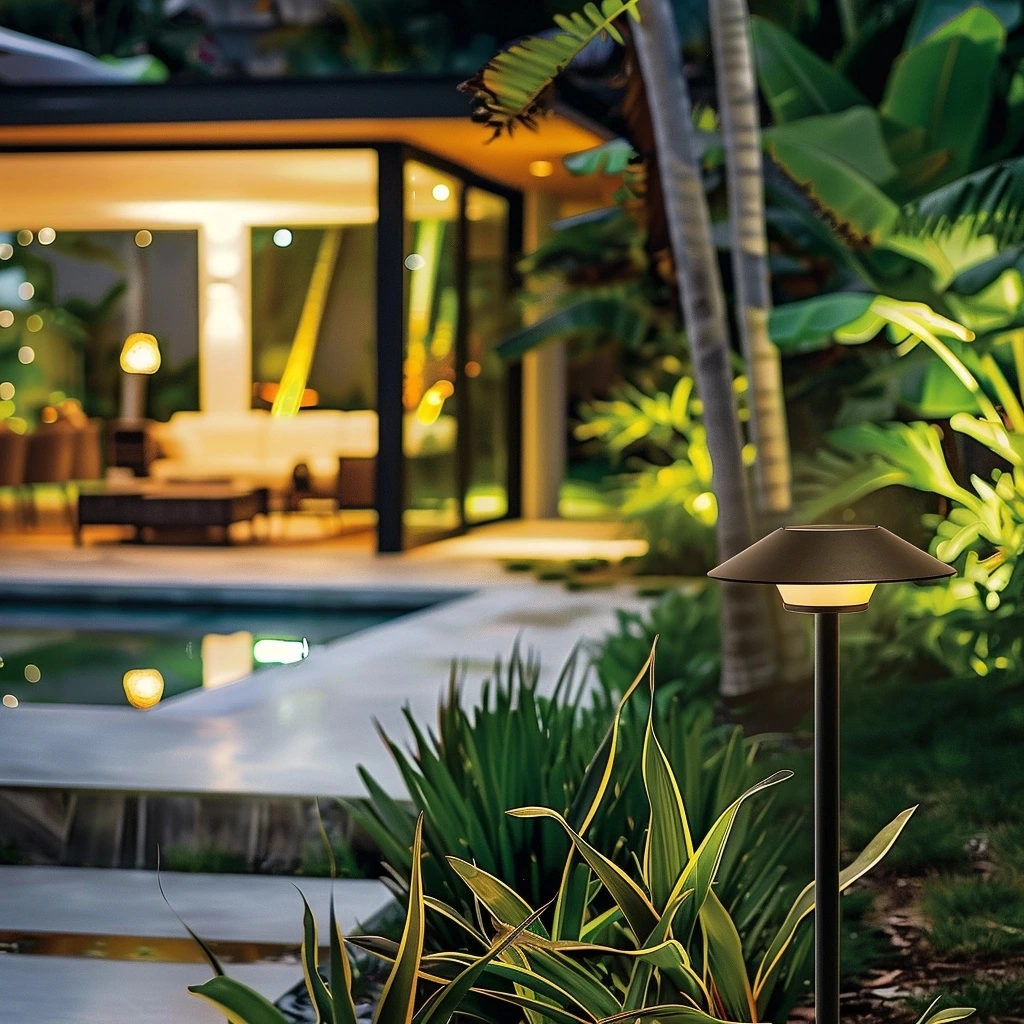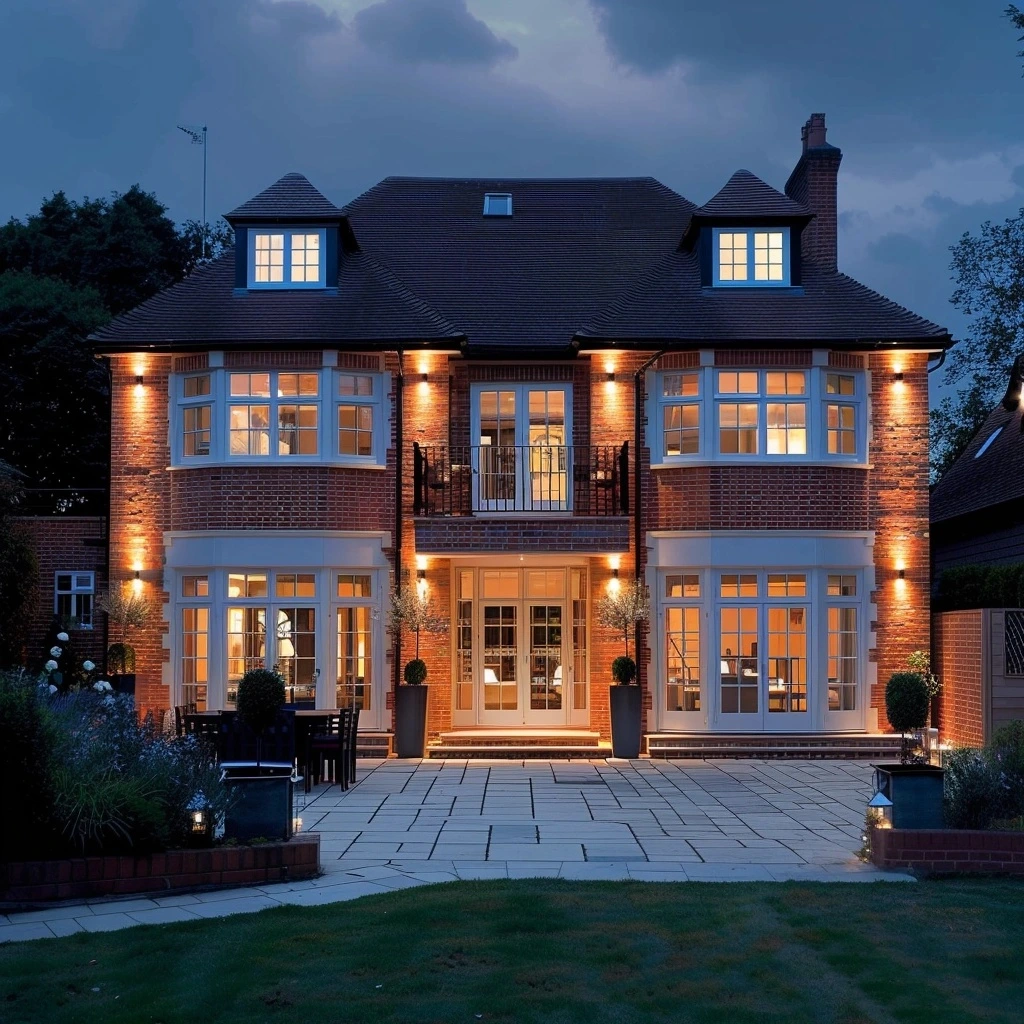Want stunning lawn lighting without high energy costs? Discover why low-voltage landscape lighting transforms gardens safely and affordably. Learn the benefits now!
Your garden transforms into something magical after sunset, but only if you have the right lighting to showcase its beauty. Many homeowners struggle with dark outdoor spaces that limit evening enjoyment and fail to highlight their landscaping investments. Traditional high-voltage lighting systems often come with hefty installation costs, safety concerns, and sky-high electricity bills that make beautiful outdoor lighting feel out of reach.
Table of Contents
Low-voltage landscape lighting offers the perfect solution, combining stunning visual effects with practical benefits that make sense for any budget. This comprehensive guide explores why choosing low-voltage systems for your garden creates the outdoor oasis you’ve always wanted while delivering long-term value and peace of mind.

What is Low-Voltage Lighting?
Low-voltage lighting operates at 12 volts instead of the standard 120 volts used in household electrical systems. This dramatic voltage reduction requires a transformer to step down the power from your home’s electrical panel to the safe operating level needed for 12v outdoor lights.
The system consists of several key components that work together seamlessly. The transformer serves as the heart of the system, converting high-voltage electricity to low-voltage power while providing multiple connection points for your lighting circuits. Low voltage led landscape lighting fixtures deliver bright, efficient illumination while consuming minimal energy. Wired landscape lights use specialized low-voltage cables that carry power safely underground or along surfaces without the extensive safety requirements needed for high-voltage installations.
This technology has revolutionized outdoor lighting by making professional-quality results accessible to homeowners. Unlike traditional systems that require licensed electricians for installation and extensive safety precautions, low-voltage systems can often be installed by motivated DIY enthusiasts or landscape professionals.
What are the Advantages of Low-Voltage Lighting in Your Garden?
Low-voltage garden lighting delivers numerous advantages that make it the preferred choice for discerning homeowners. Safety stands as the primary benefit, with the reduced voltage eliminating the risk of serious electrical shock even if wires become damaged or exposed. This safety factor allows for more flexible installation options and reduces concerns about children or pets encountering electrical hazards.
Energy efficiency represents another compelling advantage, with modern low voltage led landscape lighting consuming up to 80% less electricity than traditional incandescent alternatives. This efficiency translates directly into lower monthly utility bills and reduced environmental impact. The 12 volt outdoor lights themselves last significantly longer, often providing 25,000 to 50,000 hours of operation before requiring replacement.
Installation flexibility sets low-voltage systems apart from their high-voltage counterparts. The reduced safety requirements mean wired landscape lights can be placed closer to water features, walkways, and areas where people gather. Wire runs can follow more direct paths without extensive conduit requirements, reducing both material costs and installation complexity.

Understanding Landscape Lighting
Effective landscape lighting combines artistry with technical knowledge to create outdoor environments that function beautifully day and night. The discipline encompasses multiple lighting techniques designed to achieve specific visual and practical goals.
Accent lighting highlights specific features like specimen trees, architectural details, or garden sculptures. This technique draws attention to focal points and creates visual interest throughout your outdoor space. Path lighting ensures safe navigation while adding subtle beauty along walkways, driveways, and garden borders.
Area lighting provides general illumination for patios, decks, and entertainment spaces, extending the usability of these areas into evening hours. Security lighting focuses on deterring intruders and improving visibility around entry points and vulnerable areas of your property.
Understanding these different approaches helps you create a comprehensive lighting plan that addresses both aesthetic and functional needs. The best landscape lighting designs seamlessly blend multiple techniques to create layered lighting effects that enhance your garden’s natural beauty while serving practical purposes.
Planning Your Landscape Lighting Design
Successful landscape lighting begins with thoughtful planning that considers your garden’s unique characteristics and your specific goals. Start by evaluating your outdoor space during different times of day to understand how natural light affects various areas and features.
Identify the key elements you want to highlight, including mature trees, architectural details, water features, and gathering spaces. Consider how people move through your outdoor areas and where additional lighting would improve safety and navigation. Think about views from inside your home, as well-designed outdoor lighting creates beautiful vistas through windows and glass doors.
Your lifestyle and entertaining habits should influence your lighting decisions. Families with young children might prioritize path lighting and general area illumination, while couples who frequently host outdoor dinner parties might focus more on ambient lighting that creates romantic atmospheres.
Budget considerations play a crucial role in planning, but remember that low-voltage systems offer flexibility for phased installation. You can start with priority areas and expand your system over time as budget allows. This approach lets you enjoy immediate benefits while working toward your complete lighting vision.
Mapping Out Your Exterior Lights
Technical planning transforms your lighting vision into reality through careful consideration of fixture locations, power requirements, and installation logistics. Begin by creating a scaled drawing of your property that shows existing landscaping, structures, and electrical service locations.
Mark potential fixture locations based on your design goals, considering factors like optimal lighting angles, accessibility for maintenance, and aesthetic integration with your landscaping. Calculate the total wattage requirements for each circuit to ensure your transformer can handle the electrical load.
Plan wire routes that minimize trenching while providing adequate power to all fixtures. Low-voltage systems typically allow wire runs up to 100 feet from the transformer, though voltage drop calculations may require shorter runs or larger gauge wire for optimal performance. Group 12v outdoor lights into logical circuits that can be controlled independently, allowing you to adjust lighting levels for different occasions and seasons.
Consider future expansion when planning your initial installation. Choosing a transformer with extra capacity and running spare wires to strategic locations makes it easier to add more wired landscape lights later without major system modifications.

Illuminating Trees and Plants
Trees and plants form the backbone of most garden lighting designs, offering opportunities to create dramatic visual effects while showcasing your landscaping investments. Different plants require different lighting approaches to achieve optimal results.
Uplighting works beautifully for trees with interesting trunk textures or branching patterns. Position fixtures at the base of trees and angle them upward to create striking silhouettes against walls or the night sky. This technique works especially well with ornamental trees, palm trees, and specimens with distinctive architectural qualities.
Downlighting mimics natural moonlight by positioning fixtures high in trees and directing light downward. This approach creates gentle pools of light on the ground below while providing subtle general illumination for seating areas or pathways. Large shade trees work particularly well for this technique.
Grazing techniques work well for hedges, garden walls, and plants with interesting textures. Position fixtures close to these surfaces and angle the light to skim across the texture, creating dramatic shadow patterns that add visual interest and depth to your landscape.
When planning plant lighting, consider seasonal changes in foliage and growth patterns. Deciduous trees offer different visual opportunities in summer versus winter, while fast-growing plants may require periodic fixture repositioning to maintain optimal lighting effects.
Low Voltage Landscape Lighting Saves You Money
The financial benefits of low-voltage landscape lighting extend far beyond the initial purchase price, creating long-term savings that make these systems an excellent investment. Energy efficiency stands as the primary source of ongoing savings, with 12 volt outdoor lights consuming dramatically less electricity than traditional alternatives.
A typical low voltage led landscape lighting fixture uses between 3-8 watts compared to 35-75 watts for equivalent halogen fixtures. Over the course of a year, this difference can result in hundreds of dollars in electricity savings for a complete lawn lighting system. When multiplied over the 15-25 year lifespan of quality LED fixtures, these savings often exceed the initial system cost.
Installation costs remain significantly lower for low-voltage systems due to reduced electrical requirements and safety regulations. Many installations require minimal electrical permits and can be completed by landscape professionals rather than licensed electricians. The flexibility of low-voltage wiring also reduces trenching and conduit requirements, lowering labor costs.
Maintenance expenses stay minimal with modern low-voltage LED systems. The extended lifespan of LED fixtures means fewer replacements, while the durable construction of quality low-voltage components withstands outdoor conditions with minimal service requirements. Transformer technology has also improved dramatically, with modern units offering decades of reliable service with proper installation.
Low Voltage Landscape Lighting Extends Your Day
Outdoor lighting fundamentally changes how you experience your property by extending usable outdoor time well beyond sunset. This expansion of your living space creates new opportunities for relaxation, entertainment, and family activities that enhance your quality of life.
Evening gatherings become more frequent and enjoyable when your outdoor spaces offer comfortable lighting for dining, conversation, and activities. Well-designed lawn lighting creates inviting atmospheres that encourage people to linger outdoors, whether for intimate family dinners or larger social gatherings.
Seasonal enjoyment extends throughout the year as lighting makes outdoor spaces accessible even during shorter winter days. String lights, path illumination, and accent lighting on evergreen plants create magical winter wonderlands that bring joy during the darkest months.
Safety considerations also support extended outdoor use, as proper lighting reduces the risk of trips and falls while providing clear visibility of steps, elevation changes, and obstacles. Parents feel more comfortable allowing children to play outside during evening hours when adequate lighting ensures clear supervision and navigation.
The psychological benefits of extended outdoor time include reduced stress, improved mood, and stronger connections with nature. These wellness benefits add immeasurable value to your lighting investment by supporting healthier, more balanced lifestyles for your entire family.
Low Voltage Landscape Lighting Accentuates Décor and Attractive Features
Strategic lighting transforms ordinary landscape elements into stunning focal points that showcase your property’s unique character and design investments. The key lies in understanding how different lighting techniques interact with various materials, textures, and forms to create visual drama and interest.
Architectural features like columns, arches, and decorative stonework come alive under carefully positioned accent lighting. Uplighting emphasizes vertical elements and creates dramatic shadows, while grazing techniques highlight texture and detail in masonry and stonework. These approaches turn structural elements into artistic statements that define your property’s character.
Water features benefit tremendously from thoughtful lighting design, with underwater fixtures creating mesmerizing reflections and movement effects. Fountains, ponds, and waterfalls become magical focal points that draw attention and create soothing ambiance throughout your outdoor space.
Garden art and sculptures require individualized lighting approaches based on their materials, forms, and positioning. Bronze sculptures might benefit from warm uplighting that emphasizes their rich patina, while contemporary pieces might call for cooler lighting that emphasizes clean lines and modern materials.
Seasonal decorations and plantings gain new life under proper illumination, extending their visual impact well beyond daylight hours. Holiday displays, seasonal flowers, and decorative containers become integral parts of your evening landscape when supported by appropriate lighting design.
Low Voltage Landscape Lighting Increases Property Value
Professional landscape lighting represents one of the highest-return improvements homeowners can make, with studies showing increased property values ranging from 5-20% depending on the quality and scope of the installation. This return on investment stems from both practical benefits and enhanced curb appeal that makes properties more attractive to potential buyers.
Curb appeal improvements create immediate positive impressions that influence buyer perceptions from the moment they arrive at your property. Well-lit landscaping, architectural features, and pathways convey attention to detail and quality maintenance that suggests overall property care and value.
Functional benefits like improved safety, security, and outdoor usability appeal to buyers looking for properties that support active outdoor lifestyles. Families with children particularly value properties with safe, well-lit outdoor areas that extend usable living space beyond interior walls.
Market differentiation becomes crucial in competitive real estate markets, and professional landscape lighting sets properties apart from comparable homes without these improvements. Real estate agents frequently cite landscape lighting as a feature that helps properties sell faster and for higher prices than similar homes without lighting upgrades.
The permanence of low-voltage LED systems means these improvements continue providing value for decades with minimal maintenance requirements. Unlike many home improvements that require periodic updates or replacements, quality landscape lighting systems deliver consistent performance and appearance that maintains property value over time.
Low Voltage Landscape Lighting Improves Safety and Security
Safety and security benefits make landscape lighting an essential investment for any property, providing protection for family members and deterrent effects for potential intruders. These practical advantages often justify lighting installations even before considering aesthetic benefits.
Path and step lighting prevents accidents by clearly illuminating walking surfaces, elevation changes, and potential hazards. Properly positioned fixtures eliminate dark spots and shadows that could hide obstacles or create tripping hazards. This safety benefit becomes particularly important for properties with elderly residents or frequent visitors who may be unfamiliar with outdoor layouts.
Security lighting discourages criminal activity by eliminating dark hiding spots and creating clear sight lines around your property. Motion-activated fixtures provide additional deterrent effects while conserving energy during periods of non-use. Strategic placement around entry points, garage areas, and vulnerable windows creates comprehensive security coverage.
Emergency preparedness improves significantly with permanent outdoor lighting systems that continue operating during power outages when connected to backup power sources. Having reliable illumination for evacuation routes and gathering areas provides peace of mind and practical benefits during emergency situations.
Visibility improvements benefit everyone who visits your property, from delivery personnel to emergency responders who need clear access and visibility to perform their duties safely and effectively. Well-lit address numbers, entry points, and pathways facilitate quick identification and access when every second counts.
The integration of smart controls and automation systems enhances both safety and security benefits by allowing remote monitoring and control of lighting systems. Vacation settings, automatic schedules, and smartphone controls provide flexibility and convenience that support comprehensive property security strategies.
Low-voltage landscape lighting offers the perfect combination of beauty, functionality, and value that transforms ordinary gardens into extraordinary outdoor living spaces. From energy savings and safety improvements to enhanced property values and extended outdoor enjoyment, these systems deliver benefits that justify their investment many times over. Whether you’re planning a complete landscape lighting overhaul or considering your first outdoor lighting project, low-voltage LED systems provide the reliability, efficiency, and visual impact that create lasting satisfaction and value. Discover how professional landscape lighting can transform your outdoor space into the garden paradise you’ve always envisioned.

